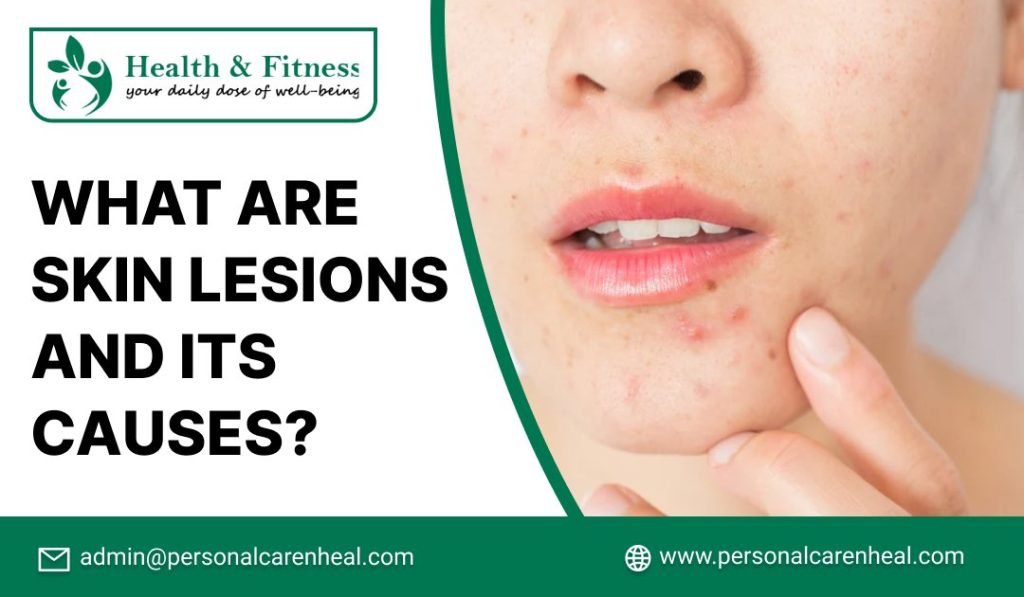What are Skin Lesions?
Everyone wants to know about what are skin lesions. These are lumps that can be detected on, or under the skin. Sebaceous cysts, also known as epidermal inclusion cysts or epidermoid cysts, lipomas, skin tags, and moles are a few examples of skin abnormalities. Skin lesions are relatively prevalent and frequently develop from localised skin damage, such as contact dermatitis or sunburns. While others, like infections, diabetes, and autoimmune or genetic illnesses, can be symptoms of underlying conditions. Even though the majority of skin lesions are benign and painless, some of them have the potential to become skin cancer because they are malignant or premalignant.
What Causes Skin Lesions?
Whenever we are facing any skin lesions problem the first answer we ever want to know what causes skin lesions.
- Moles and birthmarks are examples of skin lesions that can be inherited or acquired as a result of various circumstances.
- Infections are one of the most frequent causes of skin lesions. These include bacteria, fungi, and viruses including Candida albicans, as well as Human Immunodeficiency Virus (HIV), Human Papilloma Virus (HPV), and Herpes Simplex Virus (HSV).
- Other factors that can result in skin lesions include allergies, contact with irritants, exposure to the sun without protection, severe burns, poor circulation, insect bites, vitamin deficiencies, systematic illnesses like autoimmune diseases, some infectious diseases, kidney and liver diseases, and cancer.
Can Cancer Cause Skin Lesions?
Through the spread of cancerous cells to the skin or, more frequently, as a result of paraneoplastic syndromes, which are far-reaching clinical symptoms brought on by an internal malignancy, cancer can result in skin lesions. Examples of cutaneous paraneoplastic disorders include pyoderma gangrenosum and dermatomyositis, which result in muscle weakness and skin rashes, respectively (which is a rapidly enlarging, painful ulcer). Sweet’s syndrome, which results in skin lesions and a sudden onset of fever, and the Leser-Trélat sign, which includes the development of many seborrheic keratoses, are two more paraneoplastic disorders that affect the skin.
How to Get Rid of Skin Lesions?
Get knowledge about how to get rid of skin lesions in detail, which is mentioned below:
- Acne
- Whiteheads, pimples, blackheads, and cysts can all be symptoms of acne. For some people, it might not be harmful at all, but for others, it might leave scars or lower confidence.
- Dead skin cells and the skin’s own oil, known as sebum, clog skin pores, causing acne to appear. Additionally, bacteria that enter the blocked pore might irritate the sores.
- OTC medications that contain salicylic acid or benzoyl peroxide may work well for those with mild acne. In 4 to 8 weeks, these products typically start to show results.
- A person should visit a doctor, such as a dermatologist if their acne is more severe or OTC remedies are ineffective.
- Eczema
Eczema is widespread and frequently manifests as irritated, rosy patches of skin. Anywhere in the body, they can develop. Eczema is not communicable, but experts are unsure of what causes it. Since there is no treatment for this chronic illness, managing the symptoms through medication and dietary changes is possible.
According to the National Eczema Association, those who have eczema should consider the following precautions:
- Anything that seems to make it worse, stay away from it
- Daily shower and moisturising
- Use the meds that their doctors have prescribed or suggested.
- Cold Sores
- Infection with the herpes simplex virus is spread through contact. Cold sores, which resemble blisters, may occur on or around the lips before a person even knows they have it. The sores could hurt or tingle.
- Every now and then, cold sores seem to recur. Various circumstances, including stress and sunlight exposure, might cause an outbreak of the sores.
- In a few weeks, cold sores typically disappear on their own.
- To reduce symptoms and hasten the healing process, some people use over-the-counter lotions that include acyclovir.
- Moles
Moles are rectangular or circular spots of skin that are darker than the adjacent skin. Atypical moles should be regularly monitored by people because they can develop into skin cancer. Examine them for any changes in appearance or sensation, and consult a physician if any arise.
Which of the Following is Routinely Used to Detect Spirochetes in Skin Lesions in Early Syphilis?
Darkfield microscopy and syphilis serological assays are two types of syphilis tests. In order to distinguish spirochetes from tissue fluids, darkfield is used.
How to Remove Skin Lesions Yourself?
People really want to know about how to remove skin lesions yourself. The below-mentioned tip can be helpful for you.
For the first day, keep the wound wrapped and dry. Wash the area around the wound with clean water twice a day after the first 24 and 48 hours. Alcohol and hydrogen peroxide can impede healing, avoid using them. A non-stick bandage and a thin layer of petroleum jelly, such as Vaseline, can be used to cover the wound.
Final Say
We truly hope that you got all the information regarding skin lesions. It is highly recommended to consult your doctor first before taking any medication. Personal Care N Heal also offers more information regarding health, food, mental health, fitness, cycling, etc., which you can read for the betterment of your life.



